|
|
|
|

Kariteimo 訶梨帝母, Karitei, Kishibojin, Kishimojin, Kangimo
Sanskrit = हारिती Hārītī, Hariti; Chn. = Guǐzǐ mǔ shén; Korean = Gwija mo sin 귀자모신
Hindu Mother of Child-Eating Demons. She Repents and Converts to Buddhism.
Now a Buddhist Goddess of Easy Delivery, Giver of Children, & Guardian of Children.
Often shown with Pomegranate in Right Hand (a symbol of fertility due to its many seeds).
Especially Important to Japan’s Nichiren Sect and to Devotees of the Lotus Sutra.
RELATED PAGES: Christian-Madonna Imagery | Maria Kannon
Origin = India

Kariteimo (also known as Kishibojin, Kishimojin)
Kamakura Era (Early 13th Century), Painted Wood, Height 43.9 cm
Treasure of Onjōji Temple (園城寺, also called Miidera or Mii-dera 三井寺)
in Shiga Prefecture (Designated an Important Cultural Property)
Holds pomegranate in right hand, a symbol of fertility because of its many seeds.
Visit the Temple Gallery at: www.shiga-miidera.or.jp/treasure/bi/04.htm
Above Photo Courtesy The Hidden Buddha of Japan (Page 16)
2002, Corono Books, ISBN 4-582-63395-1, Japanese Language

|
Various Japanese Spellings of Karitemo
|
|
Originally a child-devouring Yakṣa 夜叉 from Hindu lore named Hāritī, but she repents and coverts to Buddhism. In Japan, the deity’s name was transliterated as Kariteimo 訶梨帝母 or Karitei 訶利帝, and translated as Kishimojin 鬼子母神 or Kangimo 歓喜母. In Japan, Kariteimo is the protector of children and the goddess of easy delivery, child rearing, parenting, harmony between husband and wife, love, and the well-being and safety of the family. Childless women also pray to Kishimojin in hopes of becoming pregnant. Kariteimo appears in the 26th Chapter of the Lotus Sutra (Hokekyō 法華経), and is especially important to the Nichiren Sect of Buddhism. Her iconography is based mostly on the Dai Yakusha Nyo Kangimo Narahini Aishi Jōjuhō 大薬叉女歓喜母并愛子成就法. Kariteimo is just one of Japan’s many deities of children & motherhood. Kariteimo may or may not be associated with the Hindu deity Kālī (Kali, Kalika), who in relatively contemporary times is considered a mother goddess.
|
|
HARITI (Hindu Deity)
|
Sanskrit = Hāritī. Protector of children; wife of Panchika.
|
|
KARITEIMO (transliteraton)
|
訶梨帝母. Name given by Shingon sect.
|
|
KARITEI (transliteration)
|
訶利帝. Another name given by Shingon sect.
|
|
KISHIBOJIN (translated as)
|
鬼子母神
|
|
KISHIMOJIN (translated as)
|
鬼子母神
|
|
KANGIMO (translated as)
|
歓喜母
|
|
KOYASU KISHIBOJIN
Giver of Children
or Easy Delivery
|
子安鬼子母神. There is also the Koyasu Kannon Bosatsu, and the Koyasu Jizo Bosatsu. Indeed, it seems the imagery and symbolism of these deities have merged. There is also the Juntei Kannon (Skt. = Cundi, the “mother of the Buddhas”), who facilitates childbirth. Furthermore, perhaps all are associated with the Shinto goddess Koyasu-sama (deity of easy childbirth) and with the Shinto water goddess Suijin (also a deity of easy childbirth). These protectors of motherhood and children are presented here as a group.
|
|
Jūrasetsu-nyo
Ten Demon Daughters
Ten Rasetsu
|
十羅刹女. Hindu female demons, classified as Rasetsu 羅刹 (Skt. = Rākṣasīs), who torture & feed upon the flesh of the dead (those who were evil while living); the Rasetsu became guardian deities once introduced to Buddhism; they are listed in the Lotus Sutra.
|
|

|
RO
Sanskrit Seed Syllable
Kariteimo’s Mantra is:
おん どどまり ぎゃきてい そわか
On dodomari kyakitei sowaka
|
|

HISTORICAL NOTES. Kariteimo was once a female demon (named Hāritī in India mythology) who kidnapped and murdered the children of others, feeding their flesh to her many children. During her demonic period, she enlisted the aid of Ten Demon Daughters (the Jūrasetsu-nyo 十羅刹女; also called Jurasetsu Nyoshin) to steal and murder the children of other families. To break her of her evil ways, Shaka Nyorai (the Historical Buddha) hides one of her children. After looking high and low for her lost child, without success, Kariteimo turns to Shaka in despair and agony, and finally awakens to the pain and suffering she has caused countless parents and children. She repents her sins, embraces Buddha’s teachings (especially the Lotus Sutra), and transforms herself into a protector of children.
Kariteimo, along with the Jūrasetsu-nyo, vow to help protect believers in the Lotus Sutra 法華經, to defend its teachings, and to protect all those who practice those teachings. As a group, they are important guardian deities of the Nichiren sect. The ten Jūrasetsu-nyo are:
|
Ten Demon Daughters (the Jūrasetsu-nyo 十羅刹女 who serve Kariteimo 訶梨帝母)
|
|
|
Sanskrit
|
Chinese
|
Japanese Reading
|
English Translation
|
|
1
|
Lambā
|
藍婆
|
Ranba
|
Trapped or Ensnared
|
|
2
|
Vilambā or Pralambā
|
毘藍婆
|
Biranba or Biranpū
|
|
|
3
|
Kūṭadantī, Mālākūṭadantī
|
曲齒
|
Kyōshi
|
Crooked Teeth
|
|
4
|
Puṣpadantī
|
華齒
|
Keshi
|
Flowery Teeth
|
|
5
|
Makuṭa
|
黑齒
|
Kokushi
|
Black Teeth
|
|
6
|
Keśīnī
|
多髮
|
Tahotsu
|
Many Tresses or Locks, Long Haired
|
|
7
|
Acalā
|
無厭足
|
Muensoku
|
Insatiable (Never Satisfied)
|
|
8
|
Mālādhāri
|
持瓔珞
|
Jiyōraku
|
Necklace Holder
|
|
9
|
Kuntī
|
皐帝
|
Kōtai
|
|
|
10
|
Sarvasattvojahārī
|
奪一切衆生精氣
|
Datsu Issai Shūjō Shōki
|
Spirit Snatcher, Stealer of Vital Energy
|
|
Sources: Digital Dictionary of Chinese Buddhism; also see JAANUS Rasetsu 羅刹
|
|
Starting with the Kamakura Period, the deity Kariteimo is popularized among Japan’s Nichiren sect. Indeed, a well-known image of her is installed at Hokekyō-ji Temple 法華経寺 (Chiba Prefecture), reportedly carved by Nichiren 日蓮 (1222 - 1282). In Tokyo, the most famous temples where she is worshipped are those of Meguro 目黒 and Zoshigaya 雑司が谷.
IMPORTANT CAVEATS. There is much confusion about this deity. Some say she had only 100 children, others 500 or 1,000, and still others 10,000. Some accounts say she is the “Mother of Demon Sons,” that the child hidden by Shaka Nyorai was her youngest son (not daughter), and that the Jūrasetsu-nyo are not her daughters but rather the Rasetsu of Hindu lore. Kariteimo herself was originally a Yakṣa 夜叉, but the Yakṣa and Rasetsu 羅刹 share similar iconography.

|
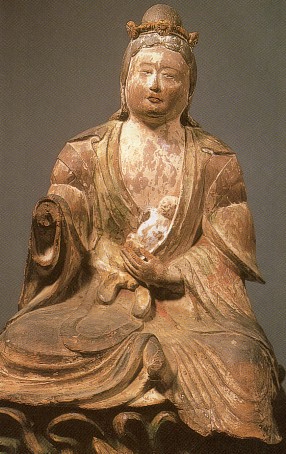
Kariteimo, Late Heian Era
Tōdaiji Temple 東大寺, Nara
Holds pomegranate in right hand
(pomegranate missing due to damage/destruction)
|
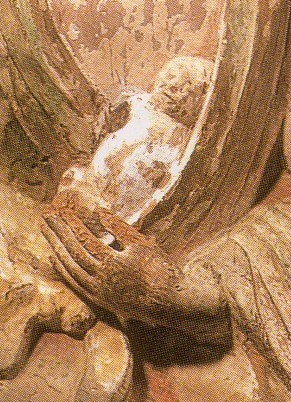
Same photo as at left.
Closeup of babe in arms.
|
|

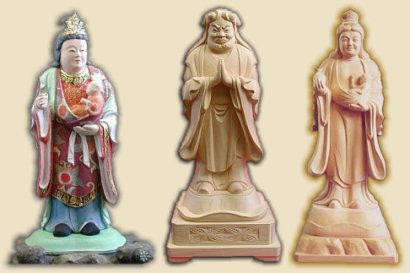
Some modern images of Kariteimo
Courtesy www.butsuzou.com/jiten/kariteimo.html
Sculptures of this deity typically come in two forms
-- the demon style and the celestial maiden style --
These statues are for believers or priests in the Nichiren Sect
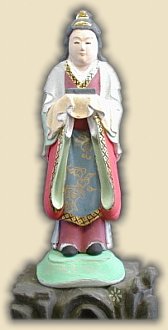
One of the Jurasetsu-nyo (Ten Demon Daughters)
Courtesy www.butsuzou.com/jiten/kariteimo.html

Among Hindu demons, the Raksa (J = Rasetsu, Skt. = Rākṣasīs) torture and feed upon the flesh of the dead (those who were evil while living); like the Hachi Bushū (Eight Legions), Rasetsu become guardian deities once introduced to Buddhism; Raksasis (female) are the demon daughters of Kishimonjin, who apparently have black powerful bodies and eat humans. They are also known as the Ten Cannibal Demon Women (the Jūrasetsu-nyo or Jurasetsu-nyo 十羅刹女). These demon daughters utter dharanis (magical chants, spells, and incantations).

Evolution of Koyasu 子安 (Child-Giving) Deities in Japan
Koyasu-sama, Koyasu Kannon, Jibo Kannon, Maria Kannon, Koyasu Jizō, Koyasu Kichibojin
For more deities, see Goddesses of Motherhood & Children
Below Text Courtesy of: “Buddism: Flammarion Iconographic Guides”
By Louis Frederic, Printed France, ISBN 2-08013-558-9, 1st Published 1995, Pages 178-180
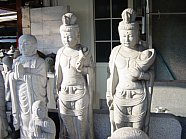 In Japan, there is a feminine form of Kannon (Skt. = Avalokitesvara) who facilitates childbirth and protects children. She is known as Juntei Kannon 准胝観音 (Skt. = Cundi, “Mother of the Buddhas”). She is a gentler Buddhist form of Kariteimo (Skt. = Hariti; “Mother of Demons;” page you are now viewing). In Japan, there is a feminine form of Kannon (Skt. = Avalokitesvara) who facilitates childbirth and protects children. She is known as Juntei Kannon 准胝観音 (Skt. = Cundi, “Mother of the Buddhas”). She is a gentler Buddhist form of Kariteimo (Skt. = Hariti; “Mother of Demons;” page you are now viewing).
Juntei Kannon is often represented seated on a chair, clothed in the Chinese manner, and holding a child in her arms. Some popular images show her nursing a baby. Owing to this aspect, she was venerated as a representation of the Christian Virgin Mary (also see Christian-Madonna Imagery) during the persecutions against Japanese converts to Christianity which took place in the Edo Period, chiefly in the seventeenth and eighteenth centuries. In fact, Japanese Christians may have created this form of Avalokitesvara offering the breast, since it is not of Buddhist origin. It is believed that this form was developed late by popular Buddhism to supplant the Shinto deity (kami) of easy childbirth, Koyasu-sama or Koyasu-gami, just as in China the effigies of Guanyin (J = Kannon) shown with a child on the knees are probably merely popular Buddhist transpositions of Taoist “child-giving” deities like Tianxin Songzi or Zhangxian.
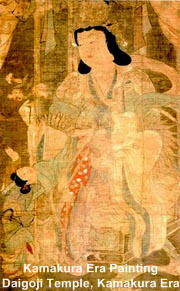 In China, Tonkin, and Japan, Juntei Kannon is venerated in a group of 20 deities, among whom she holds a secondary place. In Japan, the Shinto sanctuaries dedicated to Koyasu-sama are actually dedicated to the mythical princess of Konohana Sakkuya Hime, goddess of Mount Fuji and of cherry trees in bloom, since legend claims that she gave birth to a son while her house was devoured by flames. This may be an allusion to the creation of the lakes during an eruption of Mount Fuji. Koyasu-sama was mainly venerated in the provinces of Kanto (environs of Tokyo) and Chiba, where the women had the habit of asking her for healthy milk after childbirth in exchange for rice offerings. In China, Tonkin, and Japan, Juntei Kannon is venerated in a group of 20 deities, among whom she holds a secondary place. In Japan, the Shinto sanctuaries dedicated to Koyasu-sama are actually dedicated to the mythical princess of Konohana Sakkuya Hime, goddess of Mount Fuji and of cherry trees in bloom, since legend claims that she gave birth to a son while her house was devoured by flames. This may be an allusion to the creation of the lakes during an eruption of Mount Fuji. Koyasu-sama was mainly venerated in the provinces of Kanto (environs of Tokyo) and Chiba, where the women had the habit of asking her for healthy milk after childbirth in exchange for rice offerings.
This Koyasu-sama was subsequently confused either with Avalokitesvara (Kannon Bosatsu), or with Ksitigarbha (Jizō Bosatsu). Koyasu Kannon (Child-Giving Kannon) is sometimes herself confused with a “complementary” form, identical in form and aspect, called Kishimojin (page you are now viewing), who is the representation of the ogress Hariti (Sanskrit), who converted to Buddhism and later became a protector of children.
Kishimojin’s image was popularized in the Kamakura period by Nichiren. In the Shingon sect, she is named Kariteimo. She is represented seated on a chair, holding a pomegranate (Japanese zakuro ザクロ) in the right hand (in Asia as well as Europe, the pomegranate is the symbol of progeniture, perhaps due to its many seeds) and surrounded with naked or semi-naked children (usually three, five, seven or nine). When represented standing, she holds a lotus, an attribute of Avalokitesvara (Kannon), in the right hand. In painting, she is sometimes seated under an octagonal dais capped with a jewel. She holds a fly-wisk and has two little girls as acolytes. The most famous temples where she is worshipped are those of Meguro 目黒 and Zoshigaya 雑司が谷 in Tokyo. Her followers believe that she also possesses the power of curing sick children. Her feast day is celebrated in November.
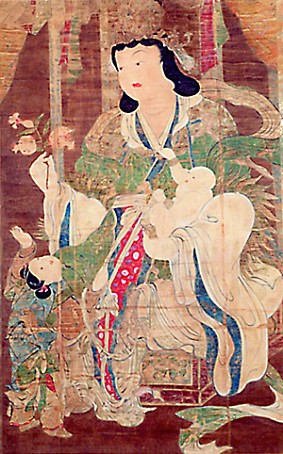
Modern reproduction of above Kariteimo painting at Daigoji Temple
See original photo at Daigoji Temple Web Site.

 Tradition relates that a statue of Koyasu Kannon was made in the eighth century in the image of the Empress Komyo (or Komei, 701-760), widow of the Emporer Shomu and mother of the Empress Koken, who became a nun in 749. Undoubtedly, this feminine aspect of Avalokitesvara (Kannon), the symbol of abnegation and love, contributed greatly to the spread of her cult in Japan. However, it was only from the fourteenth century, perhaps under the influence of the Nichiren sect, that people worshipped Koyasu Kannon as “giver of children.” Tradition relates that a statue of Koyasu Kannon was made in the eighth century in the image of the Empress Komyo (or Komei, 701-760), widow of the Emporer Shomu and mother of the Empress Koken, who became a nun in 749. Undoubtedly, this feminine aspect of Avalokitesvara (Kannon), the symbol of abnegation and love, contributed greatly to the spread of her cult in Japan. However, it was only from the fourteenth century, perhaps under the influence of the Nichiren sect, that people worshipped Koyasu Kannon as “giver of children.”
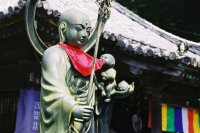 Some statues of Ksitigarbha (Jizō Bosatsu) are worshipped in the same way in Japan. They differ in no way from the normal images representing this deity, except that this form is named Koyasu Jizō, due to the powers attributed to her. Some statues of Ksitigarbha (Jizō Bosatsu) are worshipped in the same way in Japan. They differ in no way from the normal images representing this deity, except that this form is named Koyasu Jizō, due to the powers attributed to her.
In Tibet, Kariteimo is represented holding a child to her breast and a mongoose (nakula). She is also a ”dispenser of riches.” Her image appears to have been created in Gandhara (India), where she is shown as a Bodhisattva, but with visible fangs. She was also represented in Ajanta, in cave number two, seated in Rajalilasana, above a frieze composed of many naked children. Some representations of her are also found in Java (e.g., at Chandi Mendut) and in central Asia. Her effigy is often accompanied by that of a Yaksa, Pancika (reputed to be the father of her children), and a general in the army of Vaisravana (Bishamonten). <end Flammarion quote>
Editor’s Note. To minimize confusion, the above deities of motherhood and children are presented here as a group (along with the Shintō Goddess Suijin / Suiten, another deity of motherhood). Yet, there are still many unanswered questions in my mind about the origins and overlapping attributes of the many deities of motherhood.

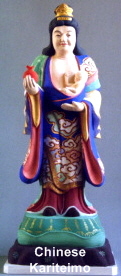 KARITEIMO (Hariti in Hindu Myth) KARITEIMO (Hariti in Hindu Myth)
Below text courtesy of Japanese Architectural & Art Net Users System
www.aisf.or.jp/~jaanus/deta/k/kariteimo.htm
The Japanese name of the Indian deity Hariti, a protector of children who was the wife of Panchika. Her name was transliterated as Kariteimo or Karitei 訶利帝, and translated as Kishimojin 鬼子母神 or Kangimo 歓喜母. She is said originally to have been an evil deity who ate children. After the Buddha hid one of her five-hundred children and made her understand the suffering of a parent who had lost a child, the reformed Kariteimo embraced Buddhism. She was worshipped in monasteries as a protector of the faith and by the general public as a protector of children. She was also, along with the ten female rasetsunyo 羂刹女, considered a protector of the Lotus Sutra and may be painted along with them. Her iconography is based on the Dai yakusha nyo kangimo narahini aishi joujuhou 大薬叉女歓喜母并愛子成就法. There are images of her from the late Heian period. She is shown dressed in Sung-dynasty robes and holds a pomegranate in her right hand. She may cradle a child with her left arm and may appear with three, five, seven, or nine children. Examples of her appearance in art include a late-Heian painting in Daigoji 醍醐寺, a Kamakura-period sculpture in Onjouji 園城寺 (Miidera 三井寺) in Shiga prefecture, and a late Heian-to-Kamakura-period sculpture in Toudaiji 東大寺 in Nara. <Editor’s Note. Photos of all three pieces appear on this site page>

Below Text from www.cebunet.com/nst/gloss.html
A female demon, said to have been a daughter of a Yaksa demon in Rajagriha. She had five hundred children (some sources say one thousand or ten thousand). According to the Kishimo Sutra (Kishimojin Sutra) and the Binaya Zoji (Monastic Rules with Respect to Various Matters), she killed the babies of other people to feed her children, and the terrified populace begged Shakyamuni for help. The Buddha then hid Kishimojin's youngest son, Binkara. She sought him throughout the world for seven days, but to no avail. In despair she finally asked the Buddha where he was. Shakyamuni rebuked her for her evil conduct and made her vow never to kill another child, then he returned her son to her. According to the Hankai Kiki Naiho Den, Kishimojin was revered in India as a goddess who could bestow the blessings of children and easy delivery. Kishimojin worship was later introduced into Japan. In the Dharani (twenty-sixth) chapter of the Lotus Sutra, she and her ten daughters pledged before the Buddha to safeguard the votaries of the Lotus Sutra.
Below Text from Flammarion Iconographic Guide to Buddhism. The Yaksha are commanded by 28 generals, of whom the chief is Pañcika 散脂迦 -- according to the Mahavamsa, Pancika (Kariteimo's husband; a general serving Bishamon) was the father of the 500 sons of Hariti [Kishimojin], known as Sanshika in Japanese.

KISHIBOJIN as Retold By Reverend Raido Hirota
Below Text from udumbarafoundation.org/TheParables/Kishibojin2.html
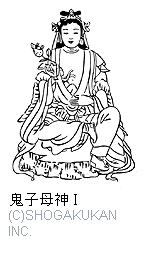 ISHIBOJIN and Jurasetsu are written on the upper left side of Gohonzon (Nichiren sect). Kishibojin is the mother-of-devils; Jurasetsu are her ten demon daughters. Kishibojin is called the mother-of-devils because she symbolizes the selfish nature of mothers whose love for their children is so extreme they become devils. ISHIBOJIN and Jurasetsu are written on the upper left side of Gohonzon (Nichiren sect). Kishibojin is the mother-of-devils; Jurasetsu are her ten demon daughters. Kishibojin is called the mother-of-devils because she symbolizes the selfish nature of mothers whose love for their children is so extreme they become devils.
Kishibojin had more than a thousand children. In order to assure their health and well being she kidnapped the babies of others and fed them to her own. At once this demonstrates her great concern for her own children while conversely revealing her disregard and unmindfulness of others. And because the task of feeding her children was too great for her to undertake alone, she enlisted the Jurasetsu, her ten demon daughters, to help her capture and murder other children.
Kishibojin's heinous activities did not go unnoticed by Shakyamuni Buddha. To teach her a lesson, the Buddha himself kidnapped her tenth demon daughter (Sarvasattvojahārī), whose English name is "Plunderer-of-Vital-Energy-of-All-Beings" and hid her away. One would think that Kishibojin would not miss one particular child when she had more than a thousand children. But since she loved all her children equally she did miss that one child.
Day and night she searched tirelessly for her one missing child. She knew she had erred. She knew what she had been doing was wrong. That is why she hated Shakyamuni, the emblem of truth and goodness, and avoided him. And as Daishonin says, "It is quite natural that [she] should, for the crooked piece of wood hates the straightness of the carpenter's string, and the dishonest man is not pleased with the honest administration of government." So for a long time Kishibojin continued to search on her own for her missing child and nearly went out of her mind from fear and worry.
Finally, driven to the point of total desperation, she confronted Shakyamuni and asked him if he knew where Sarvasattvojahārī was hidden. Without hesitation Shakyamuni took Kishibojin to her daughter and scolded to her, "By losing this one child you now know the suffering and torment other mothers feel when they lose a child." For the first time Kishibojin understood the pain and suffering of other people.

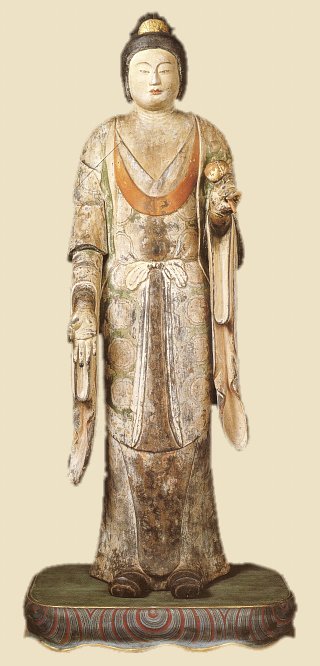
Gohō Zenshin, aka Hariti (Jp. Kariteimo)
Heian Period, 12th Century, Wood with Pigment, Height: 159.1 cm
Onjōji Temple, Shiga Prefecture

Related Matters
Kishibojin Pilgrimage (Kishibojin Mairi 鬼子母神参)
& Festival of 1000 Dumplings (Sendango Matsuri 千団子祭)
Held at Mii-dera Temple (aka Onjō-ji Temple) in Shiga Prefecture
Mii-dera 三井寺 (aka Onjō-ji Temple 園城寺) is the head temple of the Jimon branch 寺門 of Tendai 天台 Buddhism. It was originally controlled by the central Tendai stronghold Enryakuji Temple 延暦寺 on Mt. Hiei 比叡 (near Kyoto), but relations grew contentious, and Mii-dera declared independance from Enryakuji in the 13th century. Today the temple houses a famous Kamakura-era statue of Kishibojin holding a babe in her arms (see photo at top of this page). The temple, says site contributor Gabi Greve, was reportedly used for hot-water-immersion ceremonies (ubuyu 産湯 = bathing a newborn baby) for three emperors during the 8th century. The Sendango (1000 Dumplings) Festival, explains Gabi, is held between May 16-18 annually, even today. During this time, people make pilgrimages to Mii-dera Temple to pray that their children grow up safely. These visits are also called Sendango Mōde 千団子詣. The number 1000 refers to Kishibojin's evil past, when she kidnapped the children of others and fed them to her own 1000 children (the number of children varies in texts). But Kishibojin ultimately converts to Buddhism and becomes a protector of children. The 1000 dumplings thus represent the departed souls of the 1000 children devored by Kishibojin's own brood, and are meant to bring deliverance and salvation to those victims. In addition, little clay dolls (Sukusuku Ningyō すくすく人形) of all kinds are sold during the festival. <See Mii-dera Temple web site for more>
Related Matters
Priest Raigō of Mii-dera Temple -- Transforms into 1,000 Rats
Raigō (1004-1084) was an actual historical figure, a Buddhist monk of the Tendai sect attached to Mii-dera Temple (near Lake Biwa). Following text courtesy of PrintsofJapan.com. "Various chronicles relate that by virtue of Raigō's prayers a son was born to the retired emperor Shirakawa (1053-1129), in return for which Shirakawa offered to grant the priest any wish. When Raigō requested the establishment of an ordination platform at Onjō-ji [an alternate name for the temple at Mii-dera], however, the retired emperor reneged on his promise, for fear of the armed monks of the rival Tendai temple Enryaku-ji on Mt. Hiei, who enjoyed a monopoly on ordination. Casting a curse on Shirakawa, Raigō shut himself in the Buddha Hall of the Mii-dera Temple and began a fast in protest. John Stevenson continues the story: ‘Shirakawa sent conciliatory messages, but Raigo was implacable and eventually starved himself to death. Prince Atsuhisa [the son born to Shirakawa] died soon afterwards. Raigō's vengeful spirit changed into a thousand rats which infested the temple, destroying the Emperor's sacred books and scrolls and doing untold damage.’" <Also see Ryōgen and Mount Hiei: Japanese Tendai in the Tenth Century (by Paul Groner).>

LEARN MORE

|
|